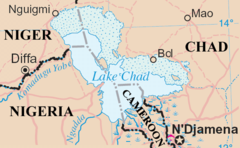Lake Chad
2007 Schools Wikipedia Selection. Related subjects: General Geography
| Lake Chad | |
|---|---|
|
|
|
| Coordinates | |
| Lake type | Desert Oasis |
| Primary sources | Chari River |
| Primary outflows | Soro & Bodele depressions |
| Catchment area | |
| Basin countries | Chad Cameroon Niger Nigeria |
| Max-length | |
| Max-width | |
| Surface area | 1,540 km² |
| Average depth | 4.11m |
| Max-depth | 10.5m |
| Water volume | 72 km³ |
| Shore length1 | 650 km |
| Surface elevation | 280 m |
| Islands | |
| Settlements | |
| 1 Shore length is an imprecise measure which may not be standardized for this article. | |
Lake Chad (in French: Lac Tchad) is a large, shallow lake in Africa. It is economically very important, providing water to more than 20 million people living in the four countries which surround it — Chad, Cameroon, Niger and Nigeria. It is located mainly in the far west of Chad, bordering on northeastern Nigeria. The Chari River is its largest source of water, providing over 90% of Lake Chad's water. The lake possesses many small islands and mudbanks, and its shorelines are largely comprised of marshes. Because it is very shallow — only 7 metres at its deepest — its area is particularly sensitive to small changes in average depth, and it consequently also shows seasonal fluctuations in size. Lake Chad has no apparent outlet, but its waters percolate into the Soro and Bodele depressions.
Lake Chad is believed to be a remnant of a former inland sea which has grown and shrunk with changes in climate over the past 13,000 years. At its largest, around 4000 BC, this lake is estimated to have covered an area of 400,000 km². Lake sediments appear to indicate dry periods, when the lake nearly dried up, around 8500 BC, 5500 BC, 2000 BC, and 100 BC. It was one of the largest lakes in the world when first surveyed by Europeans in 1823, but it has shrunk considerably since then. Climate change, due in part to global warming, and increased demands on the lake's water have accelerated its shrinkage over the past 40 years.
In the 1960s it had an area of more than 26,000 km², making it the fourth largest lake in Africa. By 2000 its extent had fallen to less than 1,500 km². This is due to reduced rainfall combined with greatly increased amounts of irrigation water being drawn from the lake and the rivers which feed it, the largest being the Chari/ Logon system, which originates in the mountains of the Central African Republic. It seems likely that the lake will shrink further and perhaps even disappear altogether in the course of the 21st century.
The lake nearly dried out in 1908 and again in 1984 and has an average depth of only 1.5 metres. As it retreats every summer, recessional agriculture is practised, while the Buduma people fish from canoes. There are many floating islands in the lake. It is home to a wide variety of wildlife, including fish, crocodiles, waterfowl and shore birds, which are important sources of food for the local human population.
In the 1960s, a plan was proposed to divert the Ubangi river into Lake Chad. The copious amount of water from the Ubangi would revitalize that dying lake and provide livelihood in fishing and enhanced agriculture to tens of millions of starving central Africans and Sahelians. The cost and the technical hurdles should be very manageable, given what it can achieve in uplifting the lot of those poorest of the African poor.

